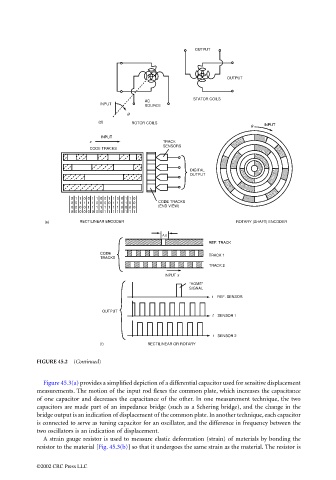Page 1166 - The Mechatronics Handbook
P. 1166
OUTPUT
OUTPUT
STATOR COILS
AC
INPUT SOURCE
θ
(d) ROTOR COILS
θ INPUT
INPUT
x TRACK
SENSORS
CODE TRACKS
DIGITAL
OUTPUT
0 1 1 0 0 1 1 0 0 1 1 0 0 1 1 0
0 0 1 1 1 1 0 0 0 0 1 1 1 1 0 0 CODE TRACKS
0 0 0 0 1 1 1 1 1 1 1 1 0 0 0 0 (END VIEW)
0 0 0 0 0 0 0 0 1 1 1 1 1 1 1 1
(e) RECTILINEAR ENCODER ROTARY (SHAFT) ENCODER
∆x
REF. TRACK
CODE TRACK 1
TRACKS
TRACK 2
INPUT x
"HOME"
SIGNAL
t REF. SENSOR
OUTPUT
t SENSOR 1
t SENSOR 2
(f) RECTILINEAR OR ROTARY
FIGURE 45.2 (Continued)
Figure 45.3(a) provides a simplified depiction of a differential capacitor used for sensitive displacement
measurements. The motion of the input rod flexes the common plate, which increases the capacitance
of one capacitor and decreases the capacitance of the other. In one measurement technique, the two
capacitors are made part of an impedance bridge (such as a Schering bridge), and the change in the
bridge output is an indication of displacement of the common plate. In another technique, each capacitor
is connected to serve as tuning capacitor for an oscillator, and the difference in frequency between the
two oscillators is an indication of displacement.
A strain gauge resistor is used to measure elastic deformation (strain) of materials by bonding the
resistor to the material [Fig. 45.3(b)] so that it undergoes the same strain as the material. The resistor is
©2002 CRC Press LLC

